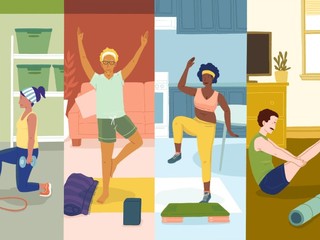The company building the outdoor lodging brand
WeChalet curates places to stay for nature and adventure enthusiasts
Read more...
To say Covid-19 changed everything is an understatement. Lockdowns and social distancing forced gyms to shut down and many people simulated those gym experiences in their own way, by taking walks, buying weights and throwing down yoga mats. Working out never felt more lonely. At the same time, 2020 and 2021 will forever be viewed as the years society woke up to innovative ways to make connections while being isolated at home.
Even though nothing compares to the in-person experience and camaraderie that comes from working out in the gym, people like the convenience of rolling out of bed and forgoing the commute. Now they can have that. I’m not referring to Peloton, Tonal or Mirror. Those are excellent resources, but they keep you at home and don’t provide the benefits of the tactile touch and the oxytocin released that only an in-person gym provides. We need those in-person moments alongside options for at-home workouts.
The nation’s biggest gyms know this. That’s why Forte has become the biggest turn-key solution for many of the largest and smallest of them, from fitness centers to dance, yoga and martial arts studios. For the gyms that have hesitated to add digital components for lack of time, resources or need, we’re now bringing their classes to life in the homes of their members. The gyms can now meet their members wherever they are, whenever it’s convenient for them and this flexibility actually increases member engagement. By doing so, they can take pride and joy in seeing their members stay fit without stepping foot inside one of their facilities, even for months.
When I started Forte, I wanted to make exercise and activity an essential part of everyone’s identity, as it is mine. Working out has been a core of my existence and my therapy. I saw what was going on with Peloton when the connected-bike wasn’t a household brand. At the time, I knew the company was onto something and that bigger brands and gyms had to find a way to use technology to reach broader audiences. It’s great to see the market catch up to this vision I had for the future. But there’s more to articulate. In this piece I want to reflect on why I think it’s so important for physical spaces to evolve with the changing culture.
For one, we create relationships with brands inside our homes and on our phones. That connectivity is key and helping our clients create those relationships means reorienting the way they view their members. It’s not just keeping equipment clean, but caring about the well-being of their members so they can make transformative change. It’s about making the gym accessible at home so the constant habit of working out becomes part of their identity.
Have a mission to transform
Nearly one in four gyms were permanently closed due to the pandemic, resulting in $29 billion in lost revenue, according to the National Health & Fitness Alliance (NHFA). At the same time, companies that provided at-home fitness options, like Peloton, saw their shares surge as they filled the void for those seeking a workout. But as the economy opened up and is likely to stay largely open, Peloton shares have taken a nosedive while shares of Planet Fitness, a large operator of in-person gyms, have skyrocketed to record levels.
It’s clear: people want to be out and about. But that doesn’t mean they won’t keep one foot at home for convenience and to avoid having to work out with a mask. While people are starting to return to their gyms, many have gotten the taste of virtual workouts and outfitting their personal space with exercise equipment. The convenience factor is hard to take away. Now some four out of five gym members want to integrate digital offerings into their training plans, according to a 2021 Les Mills Fitness Report. At-home gyms will never replace a physical gym setting, but to cater to the cultural shift, gyms have to adjust their thinking. It’s not because of fear of another lockdown. It’s for fear of not catering to the new consumer mindset and a person’s relationship with their gym.
We’ve streamed over 110,000 classes worldwide. We’ve seen 10% (for larger gyms) to up to 70% (for smaller studios) conversion rates. Clearly, members are changing the way they engage with their gym. While they may only go into the gym 1.8 times on average, a digital component gives that average a 22% lift.
Exercise should be part of our identity
When you ask someone where they place their identity, many may say family or work. There’s definitely nothing wrong with those answers. At a point in life, careers are where people seek to meet their basic needs of relevance and purpose, not to mention sustenance. But society is also realizing that work isn’t everything. If Covid taught us anything it’s that those who had comorbidities were the ones most likely to fall severely ill. Those who were healthy were largely dealing with flu symptoms.
Some 80% of Americans still don’t exercise, and Generation Z is the most obese of generations. There’s a chance to ennoble people with this sense of truth: that daily habitual exercise if even 10-15 minutes can be life-changing not just for themselves, but their family and loved ones. Think about that family member who gets you to go for that walk or do your daily stretches or get on a bike. Forte is creating these motivational prompts such as our leaderboards that allow people to keep tabs of their progress. The two-way video also helps people to feel like they’re at the gym with an instructor giving them encouragement to try harder or to fix their form.
Upselling misses the mark
The entire physical-digital setting is changing. Whether it’s hybrid work or hybrid healthcare. We’ve thought of work as going to work and punching in a clock. We’ve thought of healthcare as going to the clinic and walking away with a fix.
Today, it’s more fluid. Healthcare companies are now changing the doctor-patient relationship by not just having an annual checkup, but by allowing technology and remote care to enable 50 touch points. Workplaces incorporate Zoom meetings, webinars and more days at home. The boundaries have disappeared from home and everything else -- even though we need the physical touch points. Employers know that it takes almost a month and $4,000 to retrain a new employee on average. Churn was already a reality for gyms. Now nomadic lifestyles on top of the desire for flexible work and workout schedules means the amount it takes to acquire a new member is getting more expensive.
This means retention is key. But attracting and retaining members isn’t just the free juice bar drinks or robes in the locker rooms (though those are nice), but the opportunities to engage, connect and experience community through classes or instruction at home some of the time. For gyms and instructors, they have little heavy lifting to do beyond hitting a record button and engaging with members on the screen as much as the ones in person.
History repeats itself
We still watch movies in theaters, but we go less. We still go to the local mall or retail stores downtown, but we shop more online. We still go to the grocery store or dine outside, but we love staying home and having food delivered to us. We still go to clinics, but telehealth has become a pretty convenient and effective alternative. We will still go to gyms, but we’ve gotten the taste of working out at home as well.
Consumers want both virtual and real-world options. Many of today’s brands that started their relationship with consumers online eventually built a brick-and-mortar footprint. If gyms want to retain their members, then servicing this consumer desire for flexibility and an anytime, anywhere mentality is a must.
WeChalet curates places to stay for nature and adventure enthusiasts
Read more...Flexible and on-demand talent will surge amid budget pressures and changing work habits
Read more...If the dreamers and the realists can fuse their strong suits together, it’s an electric combination
Read more...

